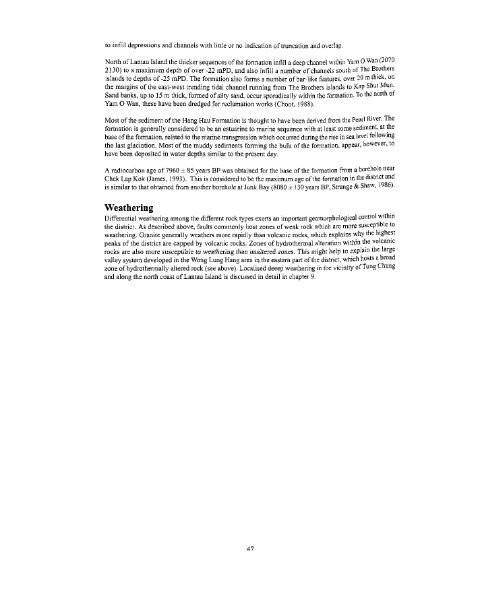5 - HKU Libraries - The University of Hong Kong
5 - HKU Libraries - The University of Hong Kong
5 - HKU Libraries - The University of Hong Kong
Create successful ePaper yourself
Turn your PDF publications into a flip-book with our unique Google optimized e-Paper software.
to infill depressions and channels with little or no indication <strong>of</strong> truncation and overlap.North <strong>of</strong> Lantau Island the thicker sequences <strong>of</strong> the formation infill a deep channel within Yam 0 Wan (20702130) to a maximum depth <strong>of</strong> over -22 mPD, and also infill a number <strong>of</strong> channels south <strong>of</strong> <strong>The</strong> Brothersislands to depths <strong>of</strong>-25 mPD. <strong>The</strong> formation also forms a number <strong>of</strong> bar-like features, over 20 m thick, onthe margins <strong>of</strong> the east-west trending tidal channel running from <strong>The</strong> Brothers islands to Kap Shui Mun.Sand banks, up to 15 m thick, formed <strong>of</strong> silty sand, occur sporadically within the formation. To the north <strong>of</strong>Yam O Wan, these have been dredged for reclamation works (Choot, 1988).Most <strong>of</strong> the sediment <strong>of</strong> the Hang Hau Formation is thought to have been derived from the Pearl River. <strong>The</strong>formation is generally considered to be an estuarine to marine sequence with at least some sediment, at thebase <strong>of</strong> the formation, related to the marine transgression which occurred during the rise in sea level followingthe last glaciation. Most <strong>of</strong> the muddy sediments forming the bulk <strong>of</strong> the formation, appear, however, tohave been deposited in water depths similar to the present day.A radiocarbon age <strong>of</strong> 7960 ± 85 years BP was obtained for the base <strong>of</strong> the formation from a borehole nearChek Lap Kok (James, 1993). This is considered to be the maximum age <strong>of</strong> the formation in the district andis similar to that obtained from another borehole at Junk Bay (8080 ± 130 years BP, Strange & Shaw, 1986).WeatheringDifferential weathering among the different rock types exerts an important geomorphological control withinthe district. As described above, faults commonly host zones <strong>of</strong> weak rock which are more susceptible toweathering. Granite generally weathers more rapidly than volcanic rocks, which explains why the highestpeaks <strong>of</strong> the district are capped by volcanic rocks. Zones <strong>of</strong> hydrothermal alteration within the volcanicrocks are also more susceptible to weathering than unaltered zones. This might help to explain the largevalley system developed in the Wong Lung Hang area in the eastern part <strong>of</strong> the district, which hosts a broadzone <strong>of</strong> hydrothennally altered rock (see above). Localised deeep weathering in the vicinity <strong>of</strong> Tung Chungand along the north coast <strong>of</strong> Lantau Island is discussed in detail in chapter 9.

















